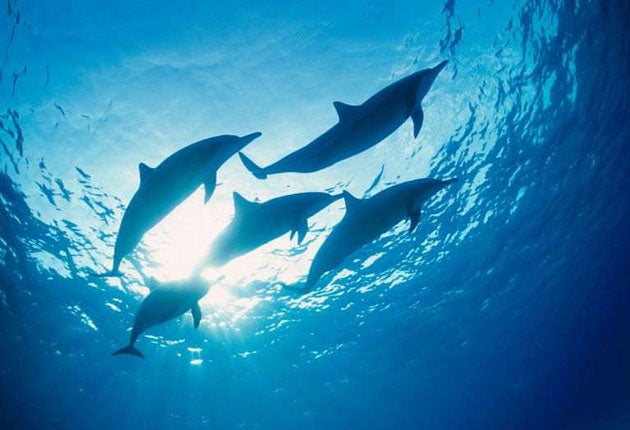Catch cuttlefish, drain off the ink, then fillet. Serves five (dolphins)
Scientists stunned by mammals' elaborate culinary preparations

Cuttlefish make a tasty meal, but getting rid of all that nasty bone and ink can be tricky. Not so for dolphins, who have been nicknamed the chefs of the sea after Australian researchers discovered them using elaborate preparations to turn the fish into a soft, chewy snack.
The scientists observed a wild Indo-Pacific bottlenose dolphin repeatedly performing a complex set of manoeuvres in the Spencer Gulf off South Australia. First, on spotting her prey, the female flushed a cuttlefish out of the dense weeds where they generally hide, into an open area with clear visibility. Adopting a vertical pose, head down and tail up, she pinned it to the sandy sea floor with her snout.
With a flick of her powerful tail, the dolphin then killed the fish with a rapid downward thrust that broke the cuttlebone. Divers who were watching heard a "loud click" as the bone snapped, the research team reported in the online science and medical journal PLoS ONE.
Next, the dolphin expelled the toxic black ink that cuttlefish squirt at predators when attacked, lifting the dead fish high in the water and repeatedly whacking it with her snout to release thick clouds of ink. Finally, it was time to get rid of the large, hard bone. The dolphin dived back down to the sea floor, where she scraped the fish along the sand, stripping off the skin until the bone popped out. And hey presto: an appetising morsel akin to calamari was ready to be tucked into.
During two underwater visits four years apart, the researchers watched the female – identified by a circular scar on her head – follow the same procedure no fewer than seven times. And, having observed a number of pods from above the water, they believe this method of preparing the perfect cuttlefish meal is widely used by dolphins in the area.
"It's a sign of how well their brains are developed," a member of the team, Mark Norman, told The Canberra Times. Dr Norman, the curator of molluscs at the Museum Victoria, added: "It's a pretty clever way to get pure calamari without all the horrible bits."
In the journal, he and his co-author, Tom Tregenza, of the University of Exeter, reported seeing clean cuttlebones bob to the surface as pods of dolphins passed, which suggested that "some or all of this behavioural sequence is not restricted to a single individual dolphin".
Moreover, divers in the area – a cuttlefish spawning ground – had noticed other dolphins performing the same sequence of actions, described by the researchers as "impressive behavioural flexibility for a non-primate animal".
An earlier study in 2005 in Western Australia provided the first evidence that dolphins are capable of group learning and using tools. A mother was seen teaching her offspring to break off sea sponges and wear them on their snouts, like protective gloves, while foraging for food on the sea floor. Other researchers have observed dolphins remove the spines from flathead fish before eating them, and break 3ft-long golden trevally into bite-sized pieces.
Last year, a wild dolphin near Adelaide was seen teaching fellow pod members to walk on their tails – behaviour normally picked up only after training in captivity. One of the group had spent a brief period in a dolphinarium 20 years ago and may have learnt the trick there. However, scientists were struck by the way the mammals appeared to have developed a shared "tail-walking culture".
Join our commenting forum
Join thought-provoking conversations, follow other Independent readers and see their replies
Comments